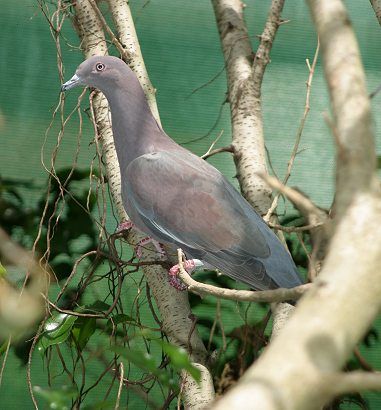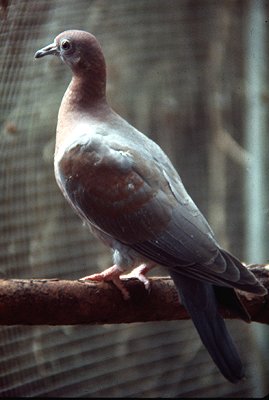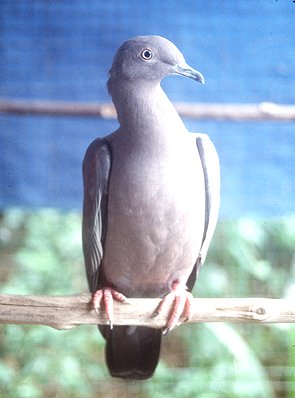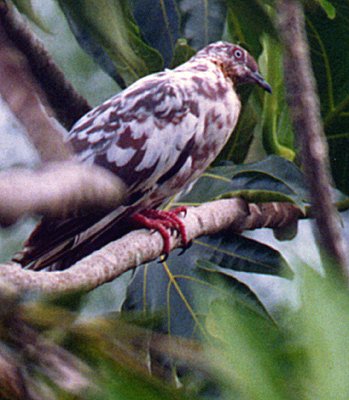|
Plain Pigeon Columba inornata Paloma Sabanera, Paloma Sencilla
|
 |
|
Photo: L. Miranda*
|
|
IDENTIFICATION: A large, gray pigeon with wine-colored overtones. In flight, a narrow white band on the wing is visible. At close range, its red feet and white eyes contrast with the plain plumage. The iridescence in the photo above is exaggerated by the photographer's flash. Length: 39-41 cm.; weight: 250 g. VOICE: Three, deep, cooing notes with the first being longer and more emphatic; also an "urr" growl when breeding; and a "wet" note when establishing territory. Audio (M. Oberle). HABITAT: In the past, the Plain Pigeon utilized a wide variety of habitats including mountain forests, thorn scrub, mangroves and open country. Currently it is found mostly in moist mountain forests. HABITS: Primarily forages in trees for fruits, berries, buds and flowers. Its favorite fruits include royal palm (Roystonea borinquena), dama de día (Cestrum diurnum), matchwood (Schefflera morototoni), trumpet tree (yagrumo, Cecropia schreberiana), and camasey (Miconia sp.). It drinks dew and rainwater from the flowers of African tulip trees, bromeliads or droplets on leaves. December-June is the main breeding period, although the Plain Pigeon may nest at any time of year. The stick nest is placed in a bamboo or hardwood tree with dense sheltering leaves, sometimes near nests of other Plain Pigeons. Typically the female lays one white egg, but may have three broods per year. Young fledge 23 days after hatching. After the breeding season, the Plain Pigeon congregates in larger flocks for foraging and roosting. STATUS AND CONSERVATION: This bird was a common species until the mid-19th Century, but is now on the federal endangered species list. Hunting and deforestation reduced its numbers dramatically until it was thought to be extinct. In 1958 a population was discovered near Cidra, and since then, a number of other populations have been located primarily at six locations: near Comerío, Caguas, Cayey, Aibonito, San Lorenzo, and Cidra. Any Plain Pigeon observed outside these areas should be reported to the PR Dept. of Natural Resources or the Puerto Rico Plain Pigeon Project (787-850-9331). The current population fluctuates at about 2,000 birds in the wild plus 40-50 in a captive breeding program at the University of Puerto Rico in Humacao. This program has developed techniques that are models for captive breeding of other rare pigeon species around the world. For example, the program has used Ringed Turtle-Doves (Streptopelia risoria) to incubate Plain Pigeon eggs, but because the Plain Pigeon has a longer incubation period of 18 days, two synchronized Turtle-Doves have to be used to incubate the Plain Pigeon egg in a relay. Although release of captive birds has been tried to supplement the wild population, the current strategy for restoring this species is to enforce the ban on dove hunting in Cidra, and enhance the protection of forest habitat. Ex-urban development in mountain areas is a major threat to this species. Other threats include nest predation by Pearly-eyed Thrashers, Red-legged Thrushes, and rats, as well as parasitism of chicks by fly maggots of Philornis pici. Scaly-naped Pigeons may force Plain Pigeons into marginal habitat for feeding and nesting sites. Hurricanes, such as Hurricane Hugo in 1989, are also a threat at the end of the breeding season. This species passed through a population "bottleneck" in the early 20th Century, so the genetic diversity of the surviving birds may be a long-term concern. RANGE: Endemic to the Greater Antilles. A regular location to find the Plain Pigeon in Puerto Rico is early or late in the day, in the trees around the baseball field at Escuela Intermedia Sabana near Comerío (PR 172, Km 1.5). TAXONOMY: COLUMBIFORMES; COLUMBIDAE. The population on Puerto Rico is currently considered a separate subspecies, Columba inornata wetmorei. This subspecies is darker, with a wider white wing patch than the form on Cuba and Hispaniola. |
|
 |
|
Photo: A. Sánchez Muñoz*
|
 |
|
Photo: A. Sánchez Muñoz*
|
 |
|
Photo: A. Sánchez Muñoz*
|
 |
|
Photo: C. Ruiz*
|





